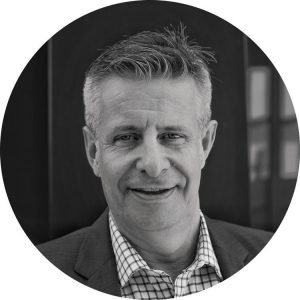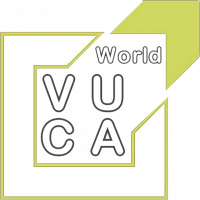The “OODA loop” – Strategy for the VUCA business world
Article by Dr. Jürgen Scherer
The U.S. Army War College coined the term VUCA in the late 80s addressing volatile, uncertain, complex and ambiguous conditions. Less known in this context is the impact of the legendary US Air Force fighter pilot John R. Boyd (1927 – 1997), who developed the so-called “O-O-D-A loop”: Observe, Orient, Decide, Act. Boyd’s influence not only revolutionized military strategy, but also formed the basis of a profound business strategy in response to VUCA times.
VUCA conditions have been associated with reports and training manuals generated by US military academies in the late 80s, early 90s. The American author Chet Richards, a Mathematician PhD, provided in his book “Certain to Win” insights into those military strategies developed, yet applying the principles to the business world of the early 2000s. The roots to both are tightly linked to Colonel John Richard Boyd (1927 -1997), United States Air Force (USAF) fighter pilot and Pentagon consultant during the 2nd half of the 20th cen
Boyd experienced as a F-86 pilot during the Korean and later as a commander in the Vietnam War certain patterns in one-on-one fighter combat, which lead to the development of a so-called theory of “energy maneuverability.” The basic idea behind is driven by agility – “whoever can handle the quickest rate of change is the one who survives” (Coram, p.328).
Boyd captured his learning in a model named “O-O-D-A loop,” also known as the “Boyd cycle.” It is well described in Robert Coram’s biography of John Boyd: Observation of the situation, Orientation in the sense of meaning, Decision derived from that and Action to be carried out (Coram, pp.327-344). Boyd realized that time, quickness is of essence, to the point that Observation and Action are happening almost simultaneously, while your adversary is still in Orientation. “It is the adaptability that gives the OODA loop its awesome power” (Coram, p.336); the one who can execute its OODA loops more quickly will succeed.
Favourable framework conditions and qualities can speed up the execution of OODA loops: intuition, trust, focus and mission. Intuition is an individual skill and competence, a feeling for complex, potentially chaotic conditions. It is often an innate trait (“Fingerspitzengefühl”), however can be learned through years of experience and self-discipline. Boyd was a strong proponent of “intuitive decision making.” Trust (within a combat) is the cohesive glue (“Esprit de Corps”) between the individuals. It “cannot be wished for or assumed, it must be earned through training and working together” (Richards, p.52). Focus is the chosen direction to achieve the target. In Boyd’s view, often by “destruction and creation,“ i.e. first creating (unexpected) diversionary maneuvers and ambiguity and then successfully emphasizing on the main focus. Quoting Muhammad Ali: “float like a butterfly, sting like a bee” (Richards, p.61). Finally, the Mission is the ultimate target. It can be challenged, but once agreed upon, it is the marching order and defines a virtual contract within the team.
Boyd’s agility concept, although going against the stream of establishment within the US military, finally became their overriding doctrine in numerous manuals of the US Air Forces, Navy, Marines and Army (Richards, pp.69-72). The successful Gulf War (operation “Desert Storm”) was largely based on this military strategy: the OODA loop as an antidote to cope with VUCA conditions (Paris 2018).
Richards illustrates in the 2nd part of his book (chapters IV-VII), based on conversations with Boyd, how the OODA loop is also an effective strategy model to address VUCA conditions in the business world. The cases of Dell, Disney, General Electric, Southwest Airlines and the Toyota Production System (TPS) at the beginning of the 21st century show applications of the principles developed by Boyd. In particular the so-called “organizational climate” is essential for a successful and sustainable implementation. Unless the antecedents of “harmony” and “flow” (Coram, p.428) are implemented and fully incorporated, the desired behavioral outcome of organizational rapidity and agility isn’t going to come to fruition.
The starting point is the individual competence, exploiting intuitive knowledge based on learning and practice, largely “self-educated.” Intuitive decision making goes well beyond the “formal decision making, of the type typically taught in business schools” and “is the product of years of experience” (Richards, p.109). Corporate learning and development programs can support the practice of such skills by providing vocational training, job rotation and cross-training opportunities: “a feel for the job has to be acquired on the job(s)” (Richards, p.112).
The alignment of individuals within the organizational unit(s) is occurring through a common sense of belonging. Unity, cohesion, oneness are the foundation of mutual trust based on shared experiences, working together to accomplish a certain purpose (Richards, p.129). The individual intuition develops into an almost blindly intuitive teamwork, an “organic whole” (Coram, p.337), representative of the group’s collective competence. Focus provides the “direction to aim the entire organization towards that goal or purpose” (Richards, p.130). It should give “real and actionable guidance,” “contribute outwards,” “reinforce mutual trust” and “promote those who use it and remove those who do not” (Richards, p.127f). In order to do so, there has to be some kind of “appreciation” in place, “a mechanism for sensing the health and progress of the organization outside the formal reporting lines” (Richards, p.134). “And finally, the mission contract, (..), provides the energy, the motive force to encourage the members of the group towards the accomplishment of the common goal” (Richards, p.130). Any mission should include an explicit or implied statement of the intent (“in order to” or equivalent), but the responsibility and accountability for the execution, once accepted, is entirely with the organizational unit(s) and their individual(s) on how to proceed.
Richards concludes by using a powerful garden metaphor: the duty of senior leaders (as highly experienced gardeners) is “to design the garden, decide what they want to grow, and prepare the proper conditions. (…) The plants grow themselves – bottom up, (…) the “system” implements itself. (…) And most important, weeds must be removed, no matter how tall they grow” (Richards, p.138f).
Boyd’s OODA loop (Observe, Orient, Decide, Act) and the corresponding emphasis on organizational culture and climate (Intuition, Trust, Focus, Mission) is to be considered an effective and efficient business model in response to VUCA conditions. It is reflective of the necessity for individual and overall organizational competence. In this regard it is an “alternative” approach, although less known, to the more widely recognized and referenced “Leadership model” by Bennis/Nanus (Vision, Communication, Positioning, Self-Development), the “dilemma flipping VUCA Prime” by Johansen (Vision, Understanding, Clarity, Agility), and most recently the “Three Pillars” model by Wollmann/Kühn/Kempf (Sustainable Purpose, Traveling Organization, Connecting Resources).
References:
Bennis, Warren G.; Nanus, Burt: Leaders: The strategies for taking charge, New York 1985 (2nd 2003)
Bourke, Daniel: How fast is your OODA loop?, mrdbourke.com, 04.04.2021
Coram, Robert: Boyd: The fighter pilot who changed the art of war, New York 2002
Johansen, Robert; Euchner, James: Navigating the VUCA World: An Interview with Bob Johansen, in: Research Technology Management, 56/1 (2013): 10-15
Paris, Joseph: The Antidote for VUCA is OODA, opexsociety.org, 28.11.2018
Richards, Chet: Certain to Win: The Strategy of John Boyd, Applied to Business, Bloomington 2004
Wollmann, Peter; Kühn, Frank; Kempf, Michael: Three Pillars of Organization and Leadership, in: Wollmann, Peter; Kühn, Frank; Kempf, Michael (Eds.): Three Pillars of Organization and Leadership in Disruptive Times, Wiesbaden 2020: 11-13
Author:
Jürgen Scherer holds an MBA and PhD in Economics from Cologne University. He has worked more than 30 years in executive positions for global corporations, mostly in Sales/Marketing and Supply Chain Management. Since 2018 he is a consultant and coach with www.bxb-exchange.com. He is teaching at various business schools in Europe and the US as well as researching and writing about organizational development.

 VUCA-WORLD
VUCA-WORLD